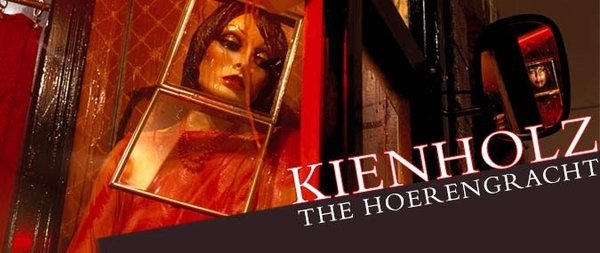Ed Kienholz
dal 16/11/2009 al 20/2/2010
Segnalato da
16/11/2009
Ed Kienholz
The National Gallery, London
Made in the Kienholzes' Berlin studio, 'The Hoerengracht' (Whore's Canal), a classic example of assemblage art, breaks down the barrier between art gallery space and the real world by using objects from everyday life to address the theme of prostitution in a direct and unadulterated way. It is one of the most significant pieces of installation art made by the Kienholzes before his death in the mid-1990s. Intense and often shocking, the ground-breaking installations connect both to the art of the past and to more contemporary developments.

'The Hoerengracht' (1983–8), by American artists Ed Kienholz (1927–1994) and Nancy Reddin Kienholz (born 1943), will transform the National Gallery's Sunley Room into a walk-through evocation of Amsterdam's Red Light District.
It will be the first time an installation of this kind has been exhibited at the National Gallery. The Hoerengracht is one of the most significant pieces of installation art made by the Kienholzes before Ed's death in the mid-1990s. Intense and often shocking, the ground-breaking installations – developed by Ed in the 1960s and continued in collaboration with his wife Nancy from 1972 – connect both to the art of the past and to more contemporary developments. Artists such as Mike Kelley, Paul McCarthy, Mike Nelson, the Chapman brothers, Tracey Emin and Damien Hirst have all produced work that is in a direct line of descent from Kienholz.
Made in the Kienholzes' Berlin studio, 'The Hoerengracht' ('Whore's Canal'), a classic example of assemblage art, breaks down the barrier between art gallery space and the real world by using objects from everyday life to address the theme of prostitution in a direct and unadulterated way.
The highly polemical street scene explores the idea of 'love for sale' – a theme that has been interpreted by artists over many centuries. Near to the evocative installation, a selection of 17th-century Dutch paintings from the National Gallery's own collection will be displayed to create a historic perspective. These will include Jan Steen's 'Interior of an Inn', Godfried Schalcken's 'A Man Offering Gold and Coins to a Girl' and Pieter de Hooch's 'A Musical Party in a Courtyard'.
Nancy Reddin Kienholz said, 'The Hoerengracht is fashioned after the Red Light District area, the Herengracht ("Gentlemen's Canal"). It is a piece for voyeurs. As the viewer walks the streets of our red light district, he or she discovers girls in windows and doorways who are offering their bodies for sale. There is music to be heard, and corners to traverse where more whores are offered.'
She continued, 'Prostitution is the oldest profession and no laws can overcome this fact. I would only hope that 'The Hoerengracht' is a kind portrait of the profession.'
The work was a return to a theme first tackled by Ed Kienholz in his earliest environmental sculpture – the now legendary 'Roxy's' (1961) – named after a real brothel in Nevada. 'The Hoerengracht' addresses issues of sordid sex, social crime and human folly. It revisits a theme ubiquitous in art of the past held in the National Gallery's own collection but here the setting has changed to a sleazy mid-1980s European street scene.
Recreating the glowing windows and mysterious doorways of Amsterdam's claustrophobic streets, The Hoerengracht's half-dressed, garishly lit mannequins enact a theatre of grim sociology, giving the viewer a peek into the seedy underbelly of the Red Light District. 'The Hoerengracht' functions as a composite street of the whole neighbourhood, creating a walk-through environment that places particular emphasis on external objects like a client's bike, dustbins and street signs.
The installation manipulates the viewer's emotions: he or she does not gain entrance into the girls' rooms but is forced to walk down the street like a typical client. One whore stands in the hallway whilst another sprawls herself across a stairway, presumably on the way up to a second-floor room. The remainder lounge in their windows or spaces, inviting men to come inside.
The texture of the assemblage is unpleasant and the dungeon-like window façades of 'The Hoerengracht' frame the faces of the girls, whose mannequin heads are in turn surrounded by tin cases. Their breasts are framed in perspex boxes, further emphasizing the fragmentation of the female body by consumer culture. At the same time, however, their hardened stance within dark doorways implies that they are aware of – and in control of – their condition.
Catalogue
'The Hoerengracht: Kienholz at the National Gallery'
By Colin Wiggins and Annemarie De Wildt
This catalogue explains how 'The Hoerengracht' resonates powerfully with paintings by Dutch masters of the 17th century, widely represented in the National Gallery Collection. Readers are also introduced to the Kienholzes, an innovative and controversial artistic partnership who have influenced contemporary artists. The authors also consider The Hoerengracht 's memorable place in Amsterdam's colourful history.
Published by the National Gallery Company in October 2009. Distributed by Yale University Press.
Press contact:
Nicola Jeffs at nicola.jeffs@ng-london.org.uk or 020 7747 2532
Press view 17 November 2009 10.30am–1.30pm
The National Gallery
Trafalgar Square, London WC2N 5DN
Open to public
Daily 10am–6pm, Friday until 9pm
Last admission 5.15pm (8.15pm Friday)
Admission free



